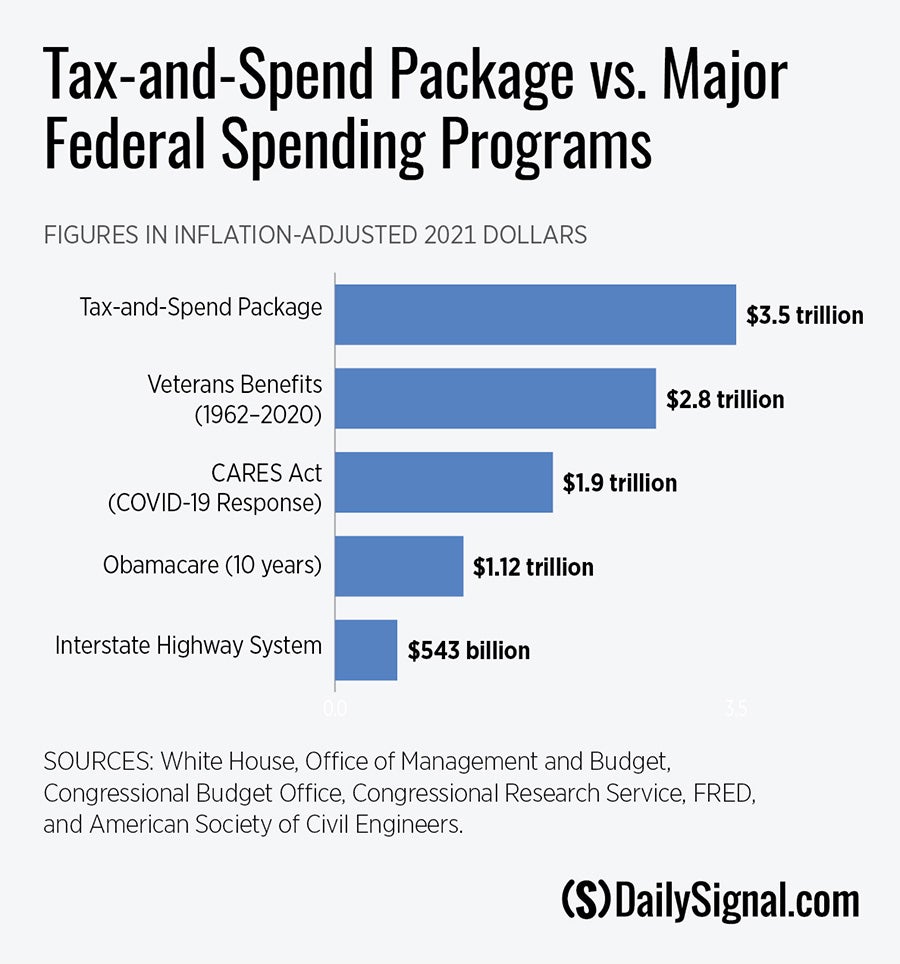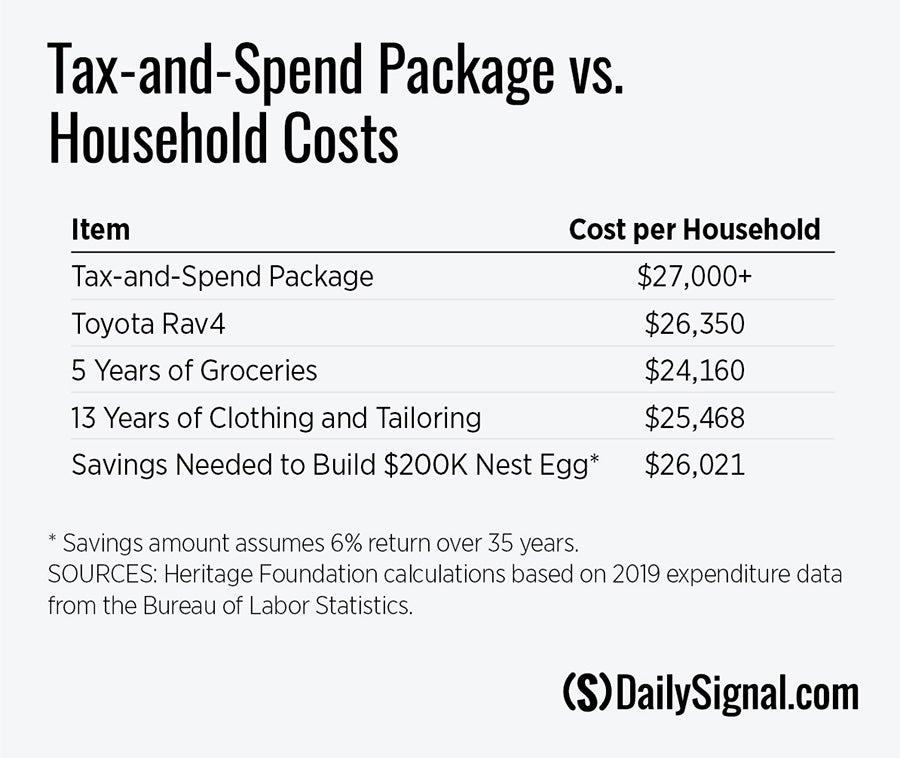The Democrats in the House of Representatives have unveiled portions of the $ 3.5 trillion spending bill over the past few weeks.
Most legislation focuses on specific issues, which allows for constructive debate. However, this bill includes benefits, immigration, taxes, energy, families and much more, which makes it extremely difficult to understand.
Providing context about the scope and cost of this tax and spending bill helps make it clear how radical it is and why some Democrats are now cracking down on it.
1. $ 27,000 cost per household
The US Census Bureau data for 2020 shows that there are 128.5 million households in the United States. If we split the cost of the $ 3.5 trillion package among each household, the numbers are sizeable relative to a typical family budget.
This legislation would cost over $ 27,000 for every household in America. That’s more than the cost of a brand new Toyota RAV4 sport utility vehicle, or five years of groceries for a typical family, or 13 years of clothing and tailoring for an average household.
The left is trying to divert attention from the exorbitant costs by pointing out tax hikes that focus on high-income households and businesses. But this is a fundamentally misunderstanding of how the economy works.
When the government increases investment taxes, there is less incentive to start or expand a business, which is the source of job creation and wage growth on which all workers depend.
In addition, the tax increases in the massive expenditure calculation would put American companies at a severe disadvantage compared to our global competitors. Over time, high taxes mean lower wages, higher prices, and poor returns for individual retirement accounts.
In contrast, the 2017 Tax Cut and Employment Act (which the tax hikes would wipe out) helped deliver strong wage growth and low unemployment before the pandemic.
While we don’t yet know exactly how much the new legislation would add to the national debt, it would likely be somewhere between $ 1 trillion and $ 2 trillion. That burden would be superimposed on the existing $ 28.4 trillion debt, which is $ 219,000 for every household in the country.
A reckless increase in debt would increase the risks to the health of the economy and increase the immoral and unsustainable burden that will be passed on to future generations.
2. A 111 year old shopping spree
Stores occasionally hold a contest where the winner can buy as much as possible in a matter of minutes. Even under these circumstances, most stores would find it impossible to get hold of $ 1,000 per second worth of goods.
The $ 3.5 trillion spending bill is equivalent to spending $ 1,000 per second for 111 consecutive years.
However, spending would be crammed to just a decade, meaning that legislation would allow for a spending frenzy of over $ 11,000 per second for those 10 years.
What would Congress buy with all that money? An army of taxpayer-funded climate activists, new welfare programs that would deter work, corporate welfare for politically favored sectors like journalism and “green” energy, and an increased risk of 1970s-style inflation.
This is not good business for the American public.
3. Far more expensive than large programs
The $ 3.5 trillion spend is huge even when compared to other major laws and long-term federal programs.

The inflation-adjusted cost of the interstate highway system to completion in 1992 was $ 543 billion. The cost of veteran services from 1962 to 2020 was $ 2.9 trillion.
Amazingly, both decade-long federal efforts cost less than the $ 3.5 trillion.
A recent example: The Coronavirus Aid, Relief and Economic Security Act, which was the main federal response to the COVID-19 outbreak, cost $ 1.9 trillion.
The initial 10-year cost of Obamacare is now $ 1.1 trillion. The cost of these two huge bills is way below the current package.
4. Over 2,400 pages of jargon, legalese
While the final bill is still in flux, what has been published by the House Committees is over 2,400 pages – and there will likely be some additions before it is said and done.
The moderate Democrats have made a modest request: they must have at least 72 hours to review the bill before a vote in the House of Representatives. However, this would be nowhere near enough time to ensure that the final product does not contain major bugs or hidden handouts.
Reading the law is not like reading a novel. Rather, legislation is a thick soup of legal matters and references to existing federal laws, which take a long time to review.
At a pace of five minutes per page, it would take a person 202 hours straight – not 72 hours – to read such a mammoth law correctly.
This legislation is just too long, too expensive, and too damaging to the economy to justify properly.
Rather than centralizing power and control in Washington DC through a series of tax increases and new entitlement programs, Congress should take a different approach: curb spending, maintain a growth-enhancing tax law, and reform existing benefit programs to make them financially sustainable.
This would pave the way for a post-pandemic economic boom that would benefit all Americans.
This piece originally appeared in The Daily Signal












/cloudfront-us-east-2.images.arcpublishing.com/reuters/JEUL2B5V7BJCFMRTKGOS3ZSN4Y.jpg)



/cloudfront-us-east-2.images.arcpublishing.com/reuters/DYF5BFEE4JNPJLNCVUO65UKU6U.jpg)

/cloudfront-us-east-2.images.arcpublishing.com/reuters/UF7R3GWJGNMQBMFSDN7PJNRJ5Y.jpg)












